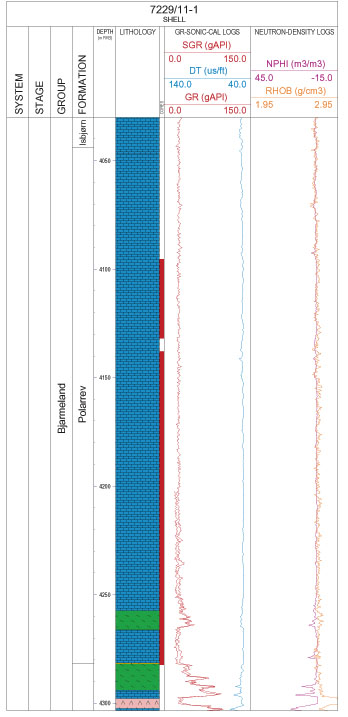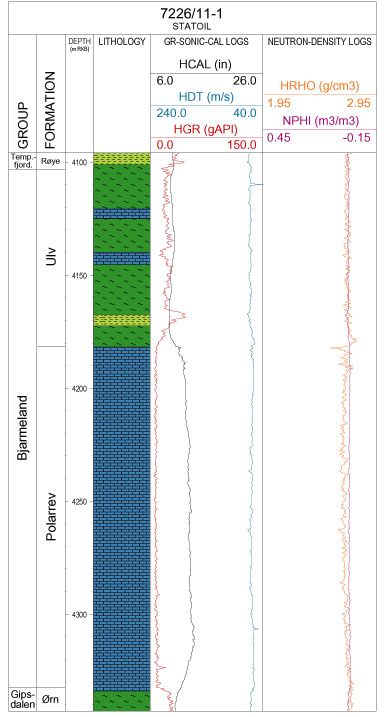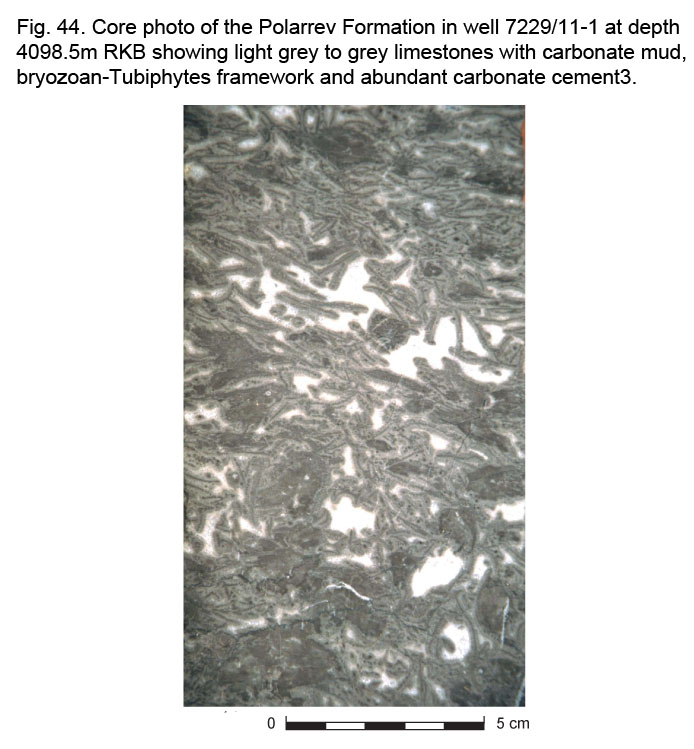Polarrev Formation (Polarrevformasjonen)
Name:
From the Norwegian name for the Polar Fox (Alopex lagopus).
Definition:
The type section is defined as the interval from 4282 m to 4046 m in well 7229/11-1 on the northern margin of the Finnmark Platform (Fig. 39; Table 1). Eight cores with a total recovery of approximately 180 m, including the base, exist (Fig. 40). The base of the formation is defined by an abrupt and sharp decrease in gamma ray log response and an accompanying decrease in interval transit time and neutron porosity log response, giving only a slight separation between the neutron and bulk density logs (Fig. 39). The cored base in the type well shows a sharp transition from underlying laminated silty to very finegrained sandy carbonates to the overlying carbonate buildups typical of the Polarrev Formation (Fig. 40).
Fig. 39. Well logs of the type section of the Polarrev Formation in 7229/11-1.
For explanation of symbols see Fig. 3.

Fig. 40. Sedimentological log of the cored part of the type section of the Polarrev Formation in well 7229/11-1.
For explanation of symbols see Fig. 3.

Reference sections:
Reference sections have been defined in the intervals from 4334 m to 4182 m in well 7226/11-1 (Fig. 41) and 4271 m to 4000 m in 7124/3-1 (Fig. 42), both located on the southern Bjarmeland Platform, and the interval from 3990 m to 3700 m in 7121/1-1 (Fig. 43) on the eastern flanks of the Loppa High. No cores exist from the reference wells.
Fig. 41. Well logs showing reference section through the Polarrev and Ulv formations in well 7226/11-1 on the Loppa High. For explanation of symbols see Fig. 3.

Fig. 42 Well logs showing reference section through the Polarrev, IsbjГёrn and Ulv formations in well 7124/3-1 on the Bjarmeland Platform. For explanation of symbols see Fig. 3.

Fig. 43 Well logs showing reference section through the Polarrev, IsbjГёrn and Ulv formations in well 7121/1-1 on the Loppa High. For explanation of symbols see Fig. 3.

Thickness:
The formation is very locally developed and is absent from most areas as it represents
isolated carbonate buildups and carbonate buildup complexes. It attains a maximum
thickness of 290 m in well 7121/1-1 on the eastern flank of the Loppa High and thins
eastward along the margin of the Bjarmeland Platform, ranging from 271 m in well
7124/3-1 to 152 m in 7226/11-1 (Fig. 38). The formation is 236 m thick in the type well on
the northern Finnmark Platform.
Lithology:
The formation consists of a variety of facies that characterise carbonate buildups. The bulk of the formation consists of bryozoan- and bryozoan/Tubiphytes-dominated wackestones and cementstones with abundant early marine cement (Fig. 44). Wackestones dominate the bioherm encountered in the type well, where a sparse assemblage of fenestrate bryozoans, brachiopods and crinoids formed a loose framework that trapped the carbonate mud. The wackestones also display Stromatactis-like cavities, which form a complex interconnected pore system. The cavities are often partly supported by fenestrate bryozoans and brachiopods, and are often filled by geopetal internal sediments with a grainstone or packstone fabric. The geopetal fabrics indicate that deposition occurred on primary slopes of up to 45o (Blendinger et al. 1997).
The limestone is massive to thickly bedded, white to light grey, locally pinkish grey andlight brownish grey in colour. In the lower part of the formation more thin bedded and silty limestones are locally present. The formation has a characteristic (very) low gamma ray response throughout, except for the thin units of silty limestones in the lower part (Fig. 39).

Lateral extent and variation:
Seismic data indicate that carbonate buildups belonging to the Polarrev Formation rim the shelf along the Loppa High and around the margins of the Nordkapp Basin (Gerard & Buhrig 1990; Nilsen et al. 1993). The buildups also form linear trends across central parts of the Finnmark Platform and across northern areas of the Bjarmeland Platform. Isolated buildup complexes occur in the Norvarg Dome-Mercurius High area and on a structural high on the northeastern Finnmark Platform. The distribution of the laterally extensive buildup complexes seems to be controlled by underlying tectonic elements and they are preferably localised to areas that experienced relatively high rates of subsidence. Therefore the best-developed buildup trends often coincide with pinch-out of salt in the underlying Gipsdalen Group. Isolated buildups have been seen to occur in the proximal parts of the basins where they form isolated patch reefs, apparently located on local palaeotopographic highs. Well data suggest that all drilled buildups have a very uniform composition although the buildups vary significantly in thickness.
The base of the formation may represent a subaerial exposure surface on structural highs, while it is a correlative conformity on the outer part of the platforms and along the margins of the depositional basin.
Age:
Fusulinids suggest a mid-Sakmarian age for the basal part of the formation in wells 7229/11-1 and 7121/1-1 and a late Sakmarian age near the top of the formation in the same wells (Davydov 1998, Davydov 2000). Comparisons with overlying units suggest that the formational top is of ?earliest Artinskian age.
Depositional environments:
The formation represents deposition in a variety of subenvironments within a bryozoandominated bioherm complex. The bulk of the bioherm is composed of repeated graded units of mud-dominated to cement-dominated bryozoan facies believed to represent individual banks. Deposition started in relatively deep water, well below storm wave base. The presence of reworked bioclastic grain-/packstone with fragmented and abraded bioclasts and reworked early marine cement indicates periods of reworking as the bioherm grew upwards into shallower water - possibly near storm wave base. The fine-grained bioclastic limestones in the lower part of the type section (between 4257.5 and 4264.5 m) and other units with higher gamma ray readings were deposited on the distal part of a carbonate ramp below normal wave base.
Correlation:
The formation is not known from the onshore areas.
